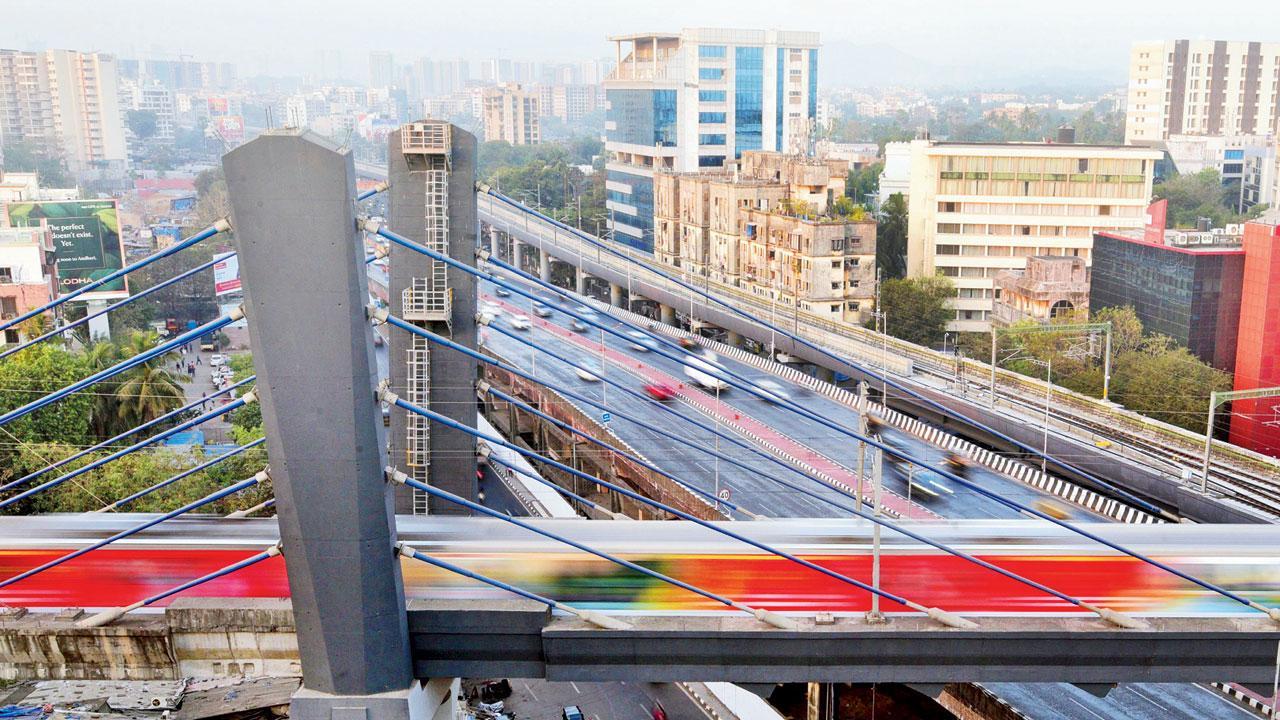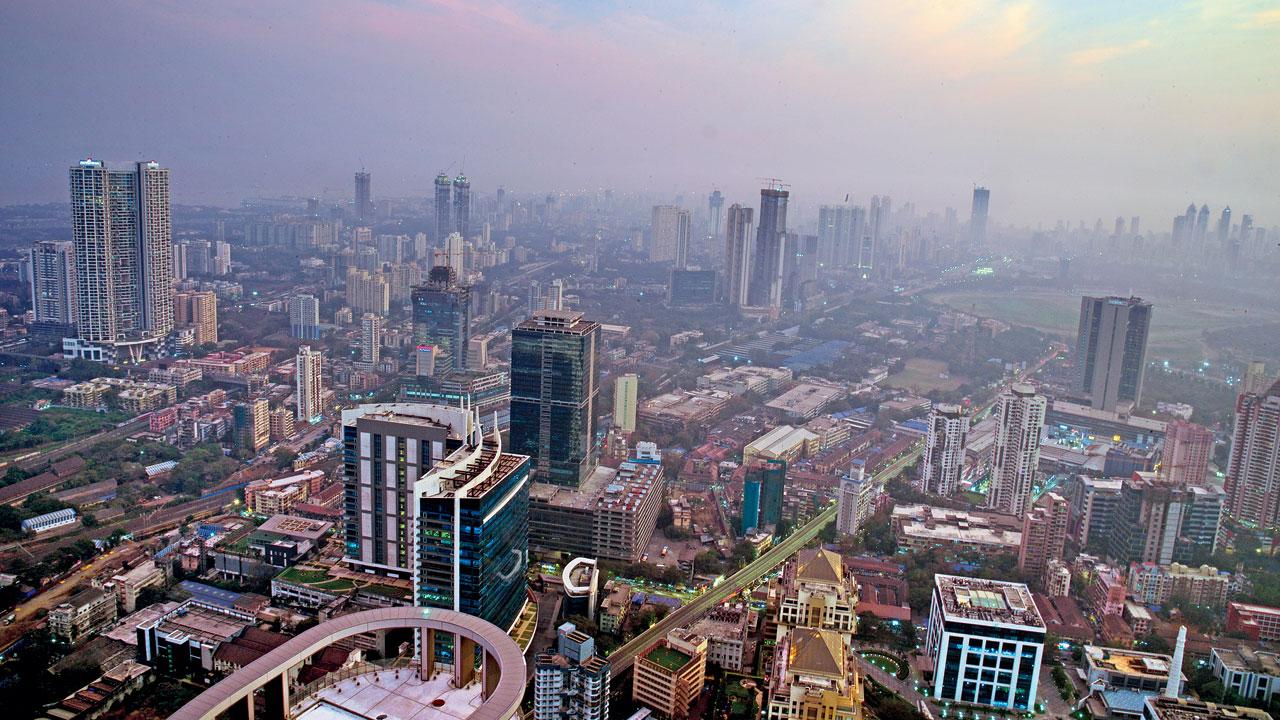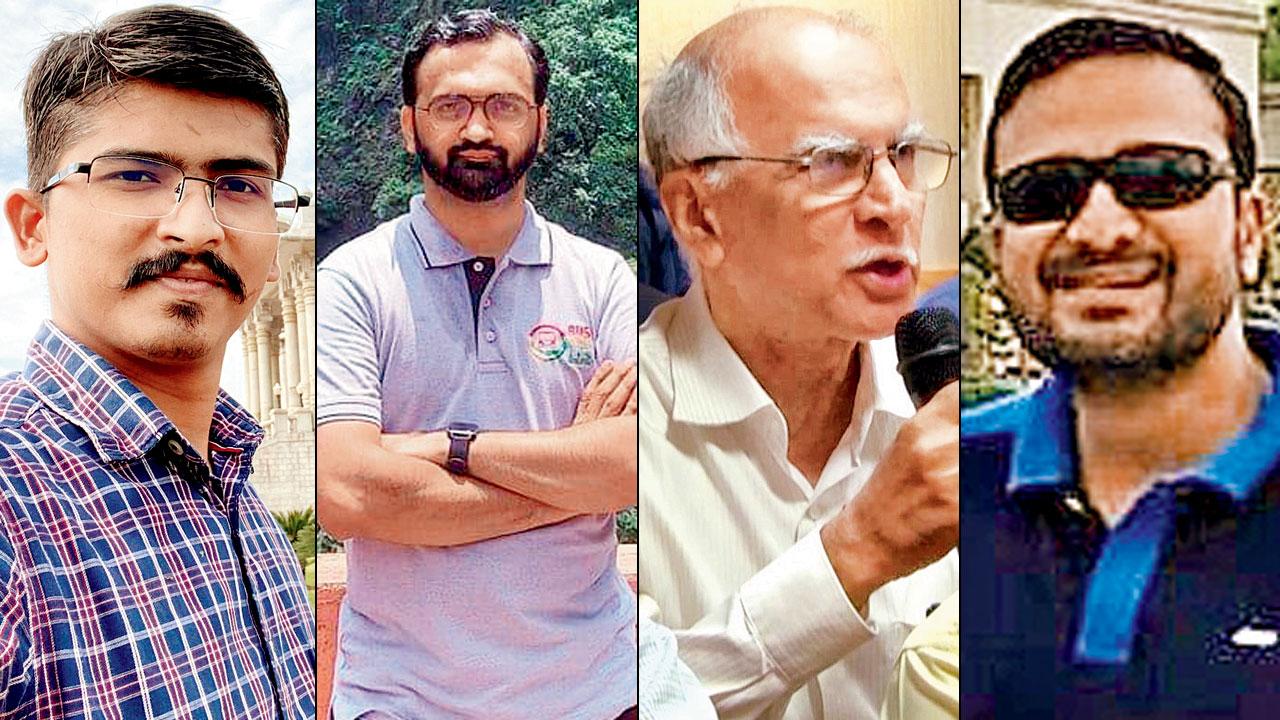With the city’s office landscape evolving rapidly, the suburban railway system is in dire need of an overhaul, commuters and experts feel

With the changing cityscape altering the commute patterns of Mumbaikars, the suburban railway system has a lot of catching up to do. Pics/Rane Ashish
"Darr ke aage jeet hai, Dadar ke aage seat hai,” goes an age-old dad joke that used to be a hot favourite among daily commuters till around ten years ago. It held true at the time, when most Mumbai bound local trains would start emptying out at Dadar, and those who boarded from far flung suburbs would finally get a chance to sit before getting off at their stations and heading to work.
ADVERTISEMENT
Cut to 2023, when the commute to work has changed drastically, rendering the joke redundant. Today, trains on the Central line start emptying out at Ghatkopar, so that people can catch the Metro to switch to the Western line, while the same is seen at Andheri for those coming to the Central line for work. Besides, offices have now shifted from the once-preferred hotspot of south and south-central Mumbai to suburbs like Jogeshwari, Malad, Goregaon, Saki Naka, Marol, Kanjurmarg and the Bandra Kurla Complex.

South and south-central Mumbai are no longer workplace hubs, as numerous offices have now sprung up in central, western and northern suburbs
Engineer Jitesh Utekar works at Ghatkopar. Every morning, he starts from his Panvel residence at 8.30 am, so that he can catch the 8.49 am Panvel-CSMT train and reach his office at 10 am sharp. To do this, he has to change two trains and his average travel time each way is one and a half hours. Evenings are as difficult for him as his mornings are, as the rush at Kurla, where he switches trains, is immense and all Panvel bound trains are fully packed on their way from CSMT, Wadala Road or Andheri.
“At Kurla, it takes a minimum of 10 minutes to change platforms and switch trains during morning peak hours, thanks to the fact that there are only three narrow foot over bridges despite the heavy crowd. It would really help if there were trains starting from Kurla towards Panvel. These can be introduced once the new elevated Kurla station is complete, so that Navi Mumbai residents can commute to places like BKC, Saki Naka, Vikhroli and Ghatkopar with ease,” says Utekar.
Recently, the Railway administration, in a bold decision, moved the starting point of certain suburbs-bound trains from Dadar to Parel, in keeping with the changing crowding patterns and shift in office spaces, a large number of which are now based in locations like Prabhadevi, Lower Parel and Worli.
AV Shenoy, a senior transport expert with Mumbai Mobility Forum and Mumbai Vikas Samiti, says that with the Mumbai Metros taking their own time in getting operational, the suburban railway system still needs a lot of change to better serve the daily commuter.

Janardan Nikanlje, Harshad Joshi, AV Shenoy and Vijay Aravamudhan
“Both WR and CR as well as the Mumbai Rail Vikas Corp (MRVC) should be in touch with MMRDA and BMC to keep track of the changing demographic of Mumbai. This way, they can enhance their own infrastructure by monitoring the increasing footfalls on various stations around which commercial or business complexes are being built. Besides, they need to increase the number of platforms and FOBs, and have more trains stopping or terminating at key stations.”
In a bid to further ease the crowding in trains, the CR has written to over 350 firms, organisations and corporate houses across Mumbai, suggesting that they stagger their working hours, so that the crowds don’t descend on railway stations all at once. The CR has also taken the lead by implementing its own suggestion at its offices at CSMT.
With about 46 km of Metro lines functional right now, the 170-plus-year-old suburban railway system finds itself on the cusp of change. It is trying to adjust and cater to the increased crowds and changing transit patterns. Experts say it is a welcome change, but stress on the need for more micro adaptations, like smaller terminal stations at more locations, given its limited infrastructure.
“Office spaces are now expanding in areas like Vashi, Airoli, Nerul, Belapur in Navi Mumbai. Sadly, however, there has been no plan to integrate metros of Mumbai and Navi Mumbai for good operability and mobility. Hence, dependence on suburban trains will remain for at least the next decade, unless there is some improvisation to integrate Metros of these two cities,” says Ghodbunder Road resident Vijay Aravamudhan, who works with a corporate firm in Navi Mumbai.
Mansoor Umer Darvesh, a member of the Divisional Railway Users’ Consultative Committee, suggests that frequency of trains to and from smaller termini stations like Jogeshwari and Goregaon also be focused upon.
“In addition to this,” he says, “more flyovers should be created to ease the traffic created by those who commute from eastern suburbs to western ones by road, so that time can be saved.”
Those who take the Western like, though, would still rather have a terminus at Dadar, and one in Andheri too, as the industrial area in Andheri employs a massive workforce from all over the city.
“Around 70 per cent local trains empty out at Andheri, and Dadar is the central marketplace of Mumbai, apart from being a connector for Western and Central lines. Frequent Andheri and Dadar locals are more useful than Churchgate locals,” says Himanshu Vartak, consultative committee passenger member for the Palghar station and member of Dahanu Vaitarna Pravasi Sevabhavi Sanstha.
The lay commuter, however, thinks that a complete revamp of the existing railway timetable is in order.
“Especially for the Central line, passenger traffic is no longer linear. Services on the trans-harbour line need to increase so that they cover the needs of more commuters, and we need more trains starting from intermediate terminal stations like Parel, Kurla and Thane towards Kalyan, rather than to CSMT,” says Harshad Joshi, a cybersecurity professional who works out of his office in Vikhroli.
Similarly, Janardan Nikalje, who works in Andheri, says that more local services originating from Thane towards Kasara and Karjat are the need of the hour.
“Adding a local train towards Kasara direction between the 5.56 pm Titwala fast and the 6.28 pm Kasara Fast will help reduce the crowd that accumulates during this 32 minute time gap,” the Titwala resident says, rattling off train timings from memory in the true spirit of the Mumbai commuter.
Growing office spaces and what Railways can adapt to
Lower Parel-Prabhadevi
Overview: The Lower Parel-Prabhadevi axis in central Mumbai has become a hub for offices since a decade and also an entertainment and leisure hotspot with pubs, bowling alleys and indoor sports complexes. The 21st century development on the old mill land has changed the character of the area.
Nearest stations: With the crowds increasing, smaller stations like Parel and Prabhadevi, formerly known as Elphinstone Road, have borne the brunt of extreme crowding, even leading to a stampede in 2017 that led to 23 deaths. Following this, the Parel station was converted into a terminus and more bridges built linking Prabhadevi and Parel.
What can be done: While CR has recently shifted 11 pairs of local trains from Dadar to Parel, there is also a need for a similar upgrade on Western Railway, at Prabhadevi or Lower Parel stations.
Future plans: The Mumbai Metro Line 3 has a new Siddhivinayak station coming up and the new corridor passes the Gokhale Road parallel to Western Railway till Mahim. This Metro connects the areas where rail transit has been missing for years like SEEPZ and passes under the existing roads through Worli where office hubs have come up and till Colaba.
Jogeshwari-Goregaon-Malad
Overview: The zone has some big business centres like Neo Corporate Plaza and Allied Business Centre, Mindspace and malls like Inorbit Mall, and Infinity Mall. Being on the border of Sanjay Gandhi National Park border, this belt is also rich in greenery, all of which is making it a new residential and commercial hub.
Nearest stations: The nearest suburban railway stations to this belt are Jogeshwari, Malad and Goregaon. While Goregaon is a harbour line terminus, the stations of Malad and Jogeshwari need to be upgraded. There are two Metro corridors on either side of Western Railway, one on Link Road in the West and the other along the highway in the East.
What can be done: Jogeshwari and Malad are up for an upgrade, with new corridors. There are plans to lay a new corridor between Goregaon and Borivli, which could have some scope for the upgrade which can entail originating or terminating of suburban trains here. The railways should examine having more Malad locals if possible.
Future plans: Plans are in the pipeline a Jogeshwari terminus for outstation trains and an upgrade of the Malad station with more lines. The planned extension of harbour line all the way to Borivali will have
direct trains from Panvel or CSMT passing through this station.
Saki Naka-Marol-Chakala
Overview: A large number of new offices, industries and corporate firms have come up in this belt after 2014, when the Mumbai Metro Blue Line One between Ghatkopar and Versova started there. In fact, the Blue Line One achieved the highest single-day ridership of 497,333 passengers in September this year, surpassing the pre-Covid-19 ridership and setting a new record. The Red Line 7 linking this hub to Dahisar has further boosted the commute.
Nearest stations: The nearest suburban railway stations on both lines are Ghatkopar on CR and Andheri on WR. Both the stations are under various stages of development. While Andheri is now getting an elevated link between its FOBs, Ghatkopar station is being converted into a two-deck station to double its capacity.
What can be done: While the WR has Andheri-originating and terminating local trains, the CR needs to find a way to increase the number of Ghatkopar-originating locals. While the station is being upgraded, there are a very few train services originating from Vidyavihar and Ghatkopar which are not enough to cater to the increasing crowds.
Future plans: The Red Line 7 is being extended to the Airport side, and the Yellow Line 2A to Bandra and further to eastern suburbs. The Green Line Four coming up at Ghatkopar would be of help too, but consolidated inter-modal connectivity is needed.
Bandra Kurla Complex (BKC)
Overview: Foresighted planning marred by utter lack of connectivity has made this area the worst office space. There is heavy dependency on road travel due to lack of proper public transport, with office goers struggling on intermediate modes of transit like autos and cabs.
App-based bus services are also proving to be the major transit mode to and from these areas, while the Chunabhatti-BKC connector, too has provided a boost to road connectivity, further adding to traffic.
Nearest stations: The nearest suburban railway stations on both lines are Kurla on CR and Bandra on WR. While Bandra station has recently been upgraded with more FOBs and connectors, the key skywalk there has been dismantled. Kurla station has been under construction for a decade now and reaching either station from BKC is always a nightmare.
What can be done: The focus needs to be on increasing their frequency to the northern end by having more Bandra-Virar-Dahanu and Kurla-Kalyan-Karjat-Kasara trains.
Future plans: The Metro Yellow Line 2B will be a saviour for all those working here, as it will take commuters directly outside the BKC in either direction. A planned suburban railway corridor between Kurla and Bandra would have been of immense help if commissioned earlier.
Powai-Kanjurmarg-MIDC
Overview: This area has seeing steady growth, more so with the Jogeshwari Vikhroli Link Road (JVLR) that came up a decade ago and the new Metro lines coming up and intersecting at Kanjurmarg. The area has direct access to key business districts of Vikhroli, SEEPZ, Airoli and Thane on one side and Andheri and Jogeshwari on the other side. As per real estate market insiders, Kanjurmarg-Powai is emerging due to its strategic location advantage and most of the office spaces are already saturated here.
Nearest stations: The nearest suburban railway station here is Kanjurmarg, which is a small halt station. Given the increase in passenger numbers, it was converted into a station with double discharge platforms to increase capacity and now is a part of Amrit Bharat station series too.
What can be done: While there is no scope for additional platforms, the additional Ghatkopar or Kurla locals towards Kalyan, Karjat and Kasara will ease pressure here as frequency goes up.
Future planns: Three Metro lines are converging around this axis. While Pink Line Six will be the key connector, as it passes through the entire Kanjurmarg-Powai-Lokhandwala area, Green Line Four between Wadala and Thane intersects Line Six at Kanjurmarg, and the underground Aqua Line Three also intersects the Line Six near SEEPZ.
Daily average ticket sales at suburban stations with growing office spaces, as of October 2023
Andheri 3.5 lakh
Ghatkopar 3.7 lakh
Bandra 2.5 lakh
Goregaon 1.6 lakh
Malad 1.6 lakh
Belapur 1.3 lakh
Vashi 1.2 lakh
Kanjurmarg 1 lakh
Vikhroli 1.1 lakh
Airoli 1.1 lakh
 Subscribe today by clicking the link and stay updated with the latest news!" Click here!
Subscribe today by clicking the link and stay updated with the latest news!" Click here!







